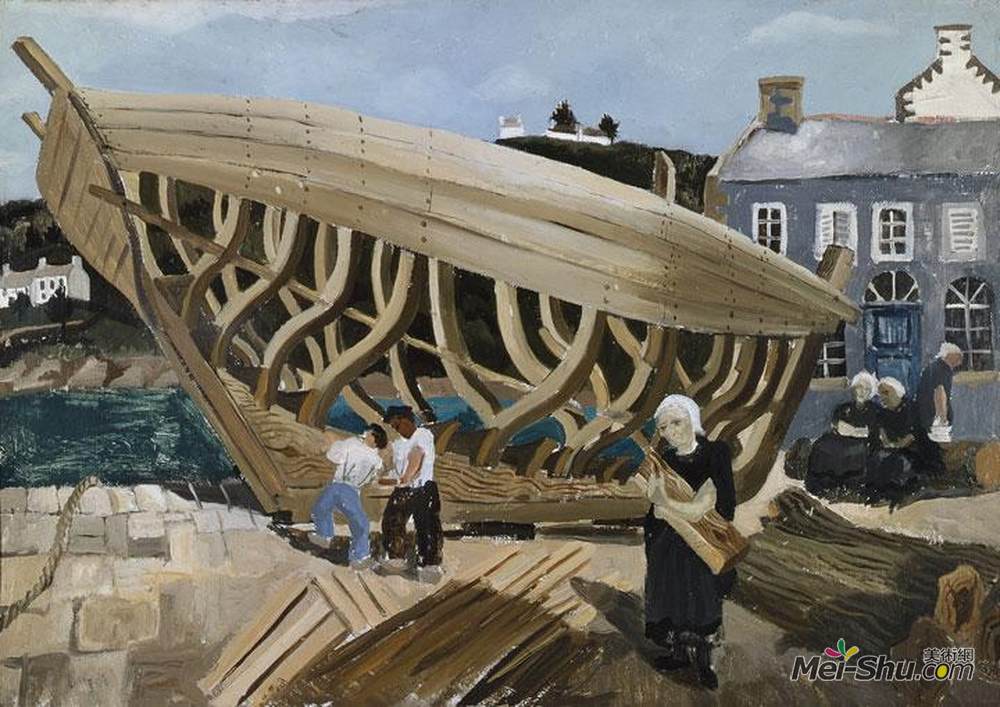 克里斯托弗·伍德(Christopher Wood)高清作品《Building the Boat, Tr&éboul》
克里斯托弗·伍德(Christopher Wood)高清作品《Building the Boat, Tr&éboul》
作品名:Building the Boat, Tr&éboul
艺术家:克里斯托弗·伍德
年代:1930
风格:后印象派
类型:风俗画
克里斯托夫·伍德的风格和方法是他一生中最后几个月的特色。受文森特的启发,他探索乡村和自然主题,寻求摆脱困境。涂装表面是厚厚的工作使用积极应用的底漆,其笔画是可见的,并不相关的最终图像。像他的实践一样,主要形象是先建立的,背景是围绕它画的。这意味着在绿海的左边和山上的房子里,引爆仍然可见。最后也是最厚的是蛋壳蓝的天空。这个构图是经过仔细构思的,并且是从港口附近建造的船的实际存在中得出的,由紧密相关的画布“新船,Tréboul”证实,画布显示船处于相同的建造状态。出乎意料的是,一个老妇人拿着一块木板。这种非常规用法似乎表明画家在手势中发现了一些特殊的意义。他给那个穿黑衣服的女人穿上了衣服,使她成为前景的焦点,也成为她同伴背后的流言蜚语。哀悼的印象是强烈的,她拥抱木头的方式暗示着慰藉。与死亡有关的问题不仅与主题有关,而且与画布上绘画的时期也相符。除了伍德那年夏天在布列塔尼的几个同伴外,最先见到他作品的人之一是商人露西·韦特海姆。她正准备展示他的作品,打开她的伦敦画廊,前往巴黎,特别是去看他的最新作品。她回忆说:“我第一次感觉到KIT在我面前的画架上放了一个大的新画布,这是一个令人沮丧的现象。我已经习惯了我现在拥有的绘画的深沉和色彩……他绘画的这种新心情让我感到有些震惊。"与她拥有的那些更迷幻的作品形成鲜明对比的是,吉姆·伊德不像她,他更喜欢伍德作品中清新而天真的一面,尽管他当然知道他们的黑暗。ER侧。在《生活方式》一书中,他写到《建造船只》,特雷布尔:&引述了正在建造中的船只的骨架,这些骨架预示着渔民的骨架,渔民会把船带到海上而不会返回。妻子和母亲,他们的丈夫和儿子,帮助年轻一代建立新的死亡船。自从他在信中写到这一点,我就从他的思想中看出了这一点。他是多么形象地描绘了这幅画,没有一点伤感的色彩。&埃德在1932年拥有这幅画,大概是在1930年末在艺术家的遗产分割中获得的。他曾试图使泰特信托公司对伍德的作品感兴趣,但指出这位画家被认为是“有意识的天真,而不是不可避免的”。
Title:Building the Boat, Tr&éboul
artist:Christopher Wood
Date:1930
Style:Post-Impressionism
Genre:genre painting
Building the Boat, Tréboul is characteristic of Christopher Wood's style and methods in the last months of his life. Inspired by the example of Vincent Van Gogh, he explored rural and natural themes in search of a retreat from his troubles. The painted surface is thickly worked using energetically applied primer, the strokes of which are visible and unrelated to the final image. As was his practice, the main image was established first and the background painted around it. This means that the priming is still visible in the green of the sea to the left and in the houses on the hill. Last and thickest of all was the eggshell blue of the sky.The composition is carefully conceived and derived from the actual presence of a boat being built beside the port, confirmed by a closely related canvas, The New Boat, Tréboul, which shows the boat in the same state of construction. Unexpectedly, an old woman holds a plank. This use of the unconventional seems to indicate that the painter found some particular significance in the gesture. He dressed the woman in black and made her the focus of the foreground and of the gossip of her companions behind. The impression of mourning is forceful and the way she hugs the wood suggests consolation. The implications of concerns with mortality are consistent both with the subject and with the period in which the canvas was painted.Beside Wood's few companions in Brittany that summer, one of the first people to see his output was the dealer Lucy Wertheim. She was preparing a show of his work to open her London gallery and travelled to Paris especially to see his latest paintings. She recalled: "My first feeling as Kit placed a large new canvas on the easel in front of me was one of dismay. I had got so used to the sombre depth and colouring of the paintings I now owned by him ... that this new mood in which he was painting came to me as something of a shock." The contrast with the more hallucinogenic works which she owned was indeed marked.Unlike her, Jim Ede favoured the fresh and the apparently innocent side of Wood's work, though he was of course aware of their darker side. In A Way of Life he wrote of Building the Boat, Tréboul: "skeletons of ships in process of being built, which foreshadow the skeletons of the fishermen who would take them out to sea and not return. Wives and mothers, who had sent their husbands and their sons, help a younger generation to build new ships of death. I see this in his thought since he wrote of it in a letter. How pictorially he has visualized it; without a shade of sentimentality." Ede owned the painting by 1932, having presumably acquired it in the division of the artist's estate in late 1930. He had made some attempt to interest the Tate Trustees in Wood's work, but remarked that the painter was considered "consciously na?ve and not inevitably so" within the institution.
作品名称:克里斯托弗·伍德(Christopher Wood)高清作品:Building the Boat, Tr&ampéboul
作品链接:https://www.mei-shu.com/famous/26775/artistic-169782.html
作品类别:油画
免责声明:本站部分公开资料来源于互联网,目的是用于学术交流与讨论,并不代表本网赞同其观点和对其真实性负责。如果您认为我们的侵犯了您的权益,请与我们联系(banquan#mei-shu.com #替换为@),我们将在第一时间删除相关内容。